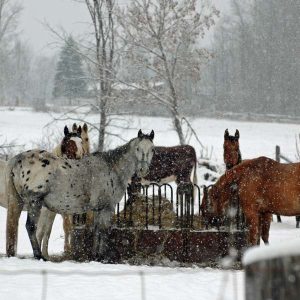
Energy Crisis
As pastures fade from green to brown, horse owners all over will soon be feeding hay to meet their horses’ energy requirements. A diet composed primarily of forage and the recommended amount of a well-fortified concentrate is all most horses need to maintain their weight. But many horses—like old horses or hard keepers—need more than the basics to stay plump and healthy through winter. To prevent an energy crisis in these calorie-needy horses, energy-dense supplements are sometimes indicated.
Horsemen have long used dietary fat to increase the energy of rations. In an extensive feed preference trial conducted at Virginia Tech, scientists confirmed that horses most readily accepted corn oil as an energy supplement. The second most widely accepted supplement was a concoction of equal amounts of corn lecithin and corn oil, with a combination of soy lecithin and corn oil rounding out the top three. Other fats used in the trial included a soy lecithin, corn oil, soybean oil mixture (50:25:25); hydrolyzed tallow flakes; peanut oil; safflower oil; a soy lecithin, soybean oil mixture (50:50); cottonseed oil; and tallow.
While corn oil may be a favorite among horses in taste tests, horsemen sometimes find using it messy and inconvenient. It has been almost a decade since the aforementioned study was completed, and since then many other fat supplements have been introduced into the marketplace. Some of these newer supplements are dry fat products.
One of the most widely used products is rice bran. At 20% fat, rice bran boosts energy levels. If you choose to feed a rice bran product, find one that is stabilized, a process that keeps the product fresh and extends shelf life. Additionally, rice bran is naturally higher in phosphorus, so inspect the label to be sure calcium has been added. A balanced ratio of calcium and phosphorus is imperative.
Rice bran comes as a meal or as pellets. Some horses prefer one over the other. Picky eaters are sometimes better off being fed the meal as horses have been known to sort the pellets from the other components of a textured feed.
Also on the market are products that combine various fat sources into a palatable mix. You’ll have to read the ingredient lists closely to tell exactly what each contains. One such product blends rice bran, flax, and other fats into a palatable combination. Because of their energy density (one provides 50% fat), these mixes tend to have lower feeding rates than rice bran.
In addition to supplying calories and replacing carbohydrates in rations, fats proffer even more advantages to horses. Potential benefits include enhanced body condition, reduced excitability, and positive changes in performance. Horses can efficiently use fat as fuel for exercise as long as they have been appropriately adapted to it. Researchers believe that one benefit of feeding fat includes a substantial reduction in heat production during exercise, which may improve stamina.
Dietary fats are also necessary for proper digestion of fat-soluble vitamins (A, D, E, and K) and provide the essential fatty acids linoleic acid and alpha-linolenic acid that are not produced by the body. The inclusion of fat in the diet—be it oil or dry, as in the case of rice bran—may improve skin condition and coat quality.
Be careful to feed supplemental fat only to horses that require added energy for maintenance of appropriate body condition. Feeding sedentary or easy keepers supplemental fat will only result in weight gain, predisposing horses to other health problems.


